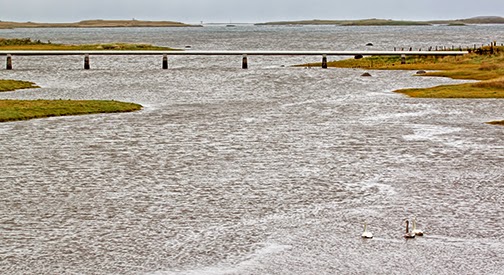Of Swans, Geese, Horses, Sheep and Eldborg.
(Eld....what?)
Leaving Akranes behind we are making our way up along the west coast to Snaefellness peninsula.
A family of Whooper Swans, Cygnus cygnus,, is peacefully foraging by the edges of a long, seemingly shallow fjord.It is raining but we stop to observe and photograph anyway.
The swan parents immediately turn back and paddle away.
But the youngster seems to have decided otherwise. Ignoring both, the parents and their warning signals, it made a hundred-and-eighty turn and graciously swims towards us rapidly increasing the distance between its parents and self.
It made its mind! No signals or body language shall lure it back!
What can the parents do about such disobedience?
Turning back to catch up with the young they somehow manage to make it clear:
Enough is enough!
The strategy works and the cygnet, having decided that we are not worth the trouble, turns its back on us and glides away.
Oh, those children!
 |
| Trumpeter Swan, Cygnus buccinator |
The Trumpeter Swan can be identified by the red on its beak.
The photo had been taken in Montana, USA.
 |
| Whooper Swan, Cygnus cygnus |
And the one with a really large patch of yellow on the beak is the whooper swan.
(There are other species of swans with yellow on the beak but this one sports the largest amount of yellow of them all.)
Because of their size and morphology, the whooper swans need very large spaces for taking off to the air. they "run" on water for quite a distance before they can lift their heavy bodies up and fly away.
Therefore they need vast bodies of water that offer not only the submerged vegetation but also the space for take-offs.
Iceland's coastal lines offer just that - vast fjords and swamps.
That's why we are starting to see them everywhere. What a treat.
In fact we are only about 70 km north from Reykjanes.
A flock of noisy geese has landed in a field half a kilometer away. More wildlife!!!!
Not sure if I am ever going to able to identify them (so far they are) I am shooting a couple of frames anyway.
Not sure if I am ever going to able to identify them (so far they are) I am shooting a couple of frames anyway.
Well, long live the marvels of the digital photography - they are the Greylag geese, Anser anser, the European species and the great-Grand-Daddys of all domesticated geese.
A waterfall, a waterfall!
Little do we know at this point of our trip that this is only one of a million or so waterfalls that we are going to see!
With all the rain coming from the ocean, water seems to be abundant in this place.
Beautiful Icelandic horses make up for the lack of other large wildlife
All are special - a very old breed hardly changed over the course of the last millenium.
Their legs are a bit shorter than those of "normal" horses (who wants to be tall in all this wind?). Their genes are actually carefully guarded by the breeders. Also, they are protected from the import of diseases by strict rules and regulations regarding the travel in or out of the country.
Their legs are a bit shorter than those of "normal" horses (who wants to be tall in all this wind?). Their genes are actually carefully guarded by the breeders. Also, they are protected from the import of diseases by strict rules and regulations regarding the travel in or out of the country.


It is windy - VERY windy! And it rains 80% of the time (it is september).
But some brave hearts, admirably, travel by bicycle anyhow. All we can do at our advanced ages is to admire their stamina - and their physical condition.
This is a picturesque part of the country (But what in Iceland isn't?).
Ahh, those icelandic sheep! They are cute in their rich, soft coats. The strands of their wool are fluffed up by the never ceasing wind. They are not too keen on close contact with people (at least that was our case) and as soon as we stop to photograph them they move to a safer distance.
Past the city of Borgarnes, is a volcanic rift that hosts a neat crater with a neat name.
It is Eldborg - translated as Fire Castle. It is a perfectly rounded crater that had been formed some 5 to 8 thousand years ago.
We are stopping to explore the area for a while - there is no need to repeat that the wind is knocking us over, so powerful it is. But the area is astonishingly beautiful (unlike the much younger Reykjanes, this one is already dressed in vegetation).
There is no need to repeat what a photo of a sign tells the visitors:

Unfortunately we do not have an extra hour in the itinerary for the day therefore we must continue without the hike.
Here one can rent horses and enjoy the country on the horseback. Those who, like I, admire any horse but view it with some primeval fear and respect can simply walk to the crater by foot.
I simply admire the colours of the lonesome farm.
A couple more photos and we are off to the main destination of the day - the Snaefellness Peninsula.



















No comments:
Post a Comment